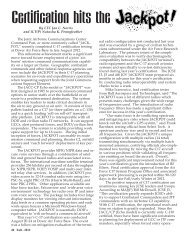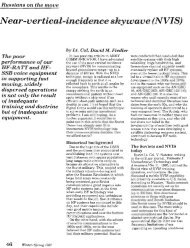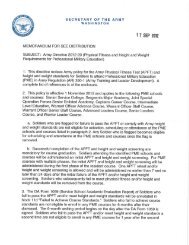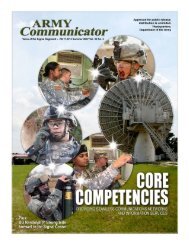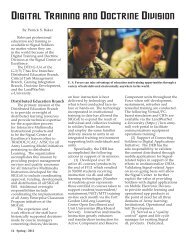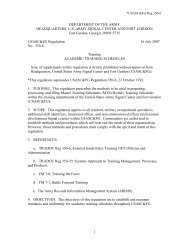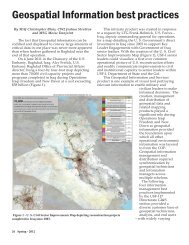AC Summer 08 WIN-T Online - United States Army Signal Center of ...
AC Summer 08 WIN-T Online - United States Army Signal Center of ...
AC Summer 08 WIN-T Online - United States Army Signal Center of ...
You also want an ePaper? Increase the reach of your titles
YUMPU automatically turns print PDFs into web optimized ePapers that Google loves.
models delivered antennas with 24<br />
inch apertures, which proved too<br />
large for mobile tactical vehicles.<br />
<strong>WIN</strong>-T has performed multiple<br />
trade<strong>of</strong>f studies between throughput<br />
performance and antenna size,<br />
weight, and power to define the<br />
optimal antenna system for each <strong>of</strong><br />
the mobile vehicle platforms. <strong>WIN</strong>-T<br />
Increment 2 will provide 18 inch<br />
aperture antennas for the TCN and<br />
PoP CIs and 16.5 inch antenna for<br />
the SNE CI.<br />
In support <strong>of</strong> future <strong>WIN</strong>-T<br />
Increments, PM <strong>WIN</strong>-T is working<br />
closely with the CERDEC to further<br />
reduce SWAP requirements for<br />
SOTM antennas via sponsorship <strong>of</strong><br />
the SOTM Active Quasioptical array<br />
antenna. This hybrid design combines<br />
the benefits from both phase<br />
arrays and real aperture technology<br />
to provide electronic switchable Ku/<br />
Ka-band in a single antenna.<br />
The concept is for the low<br />
pr<strong>of</strong>ile antenna along with the<br />
positioner motor and electronics to<br />
be enclosed in a 37 x 11 inch pancake<br />
radome. The objective weight <strong>of</strong> the<br />
antenna is approximately 100<br />
pounds. At least four prototype<br />
antenna units are planned for test in<br />
the first quarter <strong>of</strong> FY 09. It is<br />
anticipated that this new antenna<br />
design will be ready for production<br />
in the first quarter <strong>of</strong> FY 10 with a<br />
target AUPC similar to that <strong>of</strong> the<br />
SNE terminal.<br />
RF link conditions<br />
To address the radio frequency<br />
link condition challenges, PM <strong>WIN</strong>-<br />
T developed and matured the<br />
Network-Centric Waveform, hosted<br />
on the MPM-1000 modem. NCW<br />
provides four receiver/demodulation<br />
chains and two transmit/<br />
modulation chains supporting<br />
biphase shift keying and <strong>of</strong>fset<br />
quadrature phase key shifting<br />
modulation, and half and threequarter<br />
rate Forward Error Correction.<br />
NCW supports data rates from<br />
32 kbps to 6.144 Mbps. The maximum<br />
user throughput that is<br />
achieved depends on the associated<br />
SATCOM terminal, as well as the<br />
link conditions.<br />
Radio frequency links will<br />
Figure 3. NCW Scheduler Slot Plan<br />
suffer blockages and periodic<br />
outages due to terrain, tunnels,<br />
buildings, vehicular orientation, and<br />
weather effects. The SOTM system<br />
must be able to expediently acquire<br />
the satellite signal, and reacquire it<br />
should it be lost due to line-<strong>of</strong>-sight<br />
obstruction/blockage. NCW is<br />
designed for fast acquisition and<br />
requisition.<br />
The modem will reacquire<br />
bursts within a second for short<br />
duration or intermittent blockages.<br />
Should the user be in extended<br />
blockage duration, such as behind a<br />
building or in a tunnel, the SOTM<br />
system will automatically reacquire<br />
and reconnect with the network<br />
within 10 seconds when the vehicle<br />
moves out <strong>of</strong> the obstruction and a<br />
clear line-<strong>of</strong>-sight is established. In<br />
addition, PM <strong>WIN</strong>-T is considering<br />
implementation <strong>of</strong> an automated<br />
persistent slot feature within <strong>WIN</strong>-T<br />
Inc 3. This feature will use Return<br />
Order Wire statistics to automatically<br />
assign and release satellite<br />
resources during OTM and intermittent<br />
blockage conditions.<br />
The <strong>WIN</strong>-T SOTM systems will<br />
provide dynamic user throughputs<br />
nominally at 128 kbps for the SNE<br />
and 256kbps for the PoP and TCN<br />
CIs. Higher transmit user rates up to<br />
1024 kbps will be achievable but will<br />
vary and depend on weather conditions,<br />
satellite in use, location in<br />
beam footprint, and other factors.<br />
NCW employs an advanced network<br />
scheduler that maximizes network<br />
data throughput under varying<br />
atmospheric conditions and terminal<br />
population by making optimal use <strong>of</strong><br />
satellite power and bandwidth. The<br />
system adjusts itself dynamically<br />
and requires little operator intervention.<br />
The data rate, modulation/<br />
coding and power settings are<br />
dynamically scheduled for each<br />
link/burst in real time based on link<br />
conditions and satellite resource<br />
constraints. Burst scheduling recurs<br />
every 400 milliseconds. This rescheduling<br />
capability is critical,<br />
especially in OTM operations, due to<br />
the dynamic nature <strong>of</strong> radio frequency<br />
link conditions. A sample<br />
frame structure which depicts the<br />
scheduler’s efficient use <strong>of</strong> spectrum<br />
while supporting multiple apertures<br />
is provided in (Figure 3.)<br />
Networking protocol adaptations<br />
A major challenge associated<br />
with all satellite communications is<br />
long delay times. When adding the<br />
s<strong>of</strong>tware-based scheduling delay <strong>of</strong><br />
the NCW waveform to the physical<br />
propagation delay <strong>of</strong> a geosynchronous<br />
satellite, it is not uncommon to<br />
see a one second round-trip time<br />
between two terminals. Standard<br />
TCP implementations will not take<br />
full advantage <strong>of</strong> available bandwidth<br />
under such long delay conditions<br />
since the TCP protocol implements<br />
a reliable sliding<br />
acknowledgement window with a<br />
limited maximum window size, and<br />
assumes data loss is the result <strong>of</strong><br />
network congestion. <strong>WIN</strong>-T SOTM<br />
systems will make use <strong>of</strong> a Space<br />
Communications Protocol Standards<br />
<strong>Army</strong> Communicator 21



